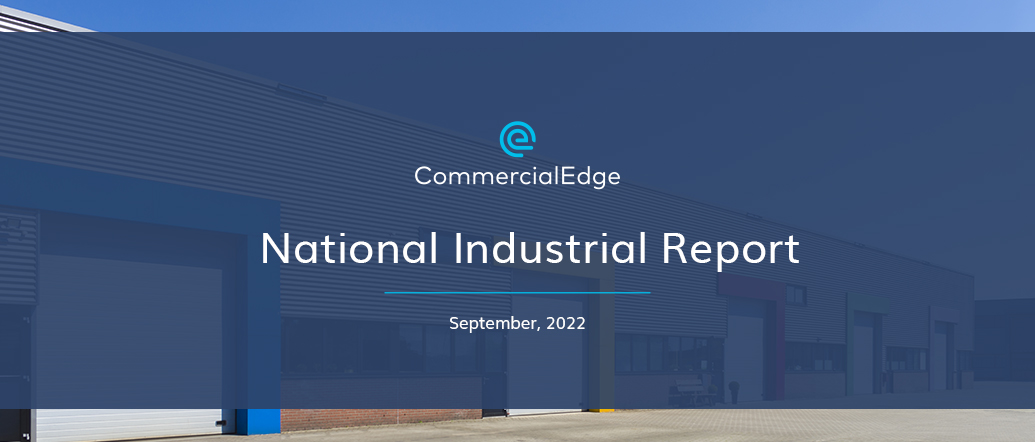Key Takeaways:
- The average U.S. in-place rent stood at $6.64 per square foot, up 5.5% year-over-year
- Down 30 basis points month-over-month, the national vacancy rate rested at 4.1%
- 703.5 million square feet of new industrial space was under construction at the end of August
- The national industrial sales volume totaled $57.6 billion in the first eight months of the year
Reshoring to Slowly Reshape Industrial
In recent years, U.S. manufacturers have become well acquainted with the risks involved in making goods abroad. Not only did the pandemic stress supply chains but other risks posed by U.S. tensions with China over Taiwan, the war in Ukraine and climate change all can jeopardize a firm’s operations. Consequently, many businesses are exploring reshoring production of goods to the U.S. The semiconductor industry is already beginning the process, which will facilitate further U.S. manufacturing, since semiconductors are critical components of countless products.
While some companies were already building semiconductors stateside, the CHIPS Act passed by Congress and signed into law by President Biden this summer will allocate $53 billion in funding to support domestic semiconductor manufacturing. Beyond chip manufacture, the Biden administration has committed billions to increase domestic supply-chain resiliency, and the Inflation Reduction Act incentivizes stateside production of renewable energy products, further boosting the long-term outlook of U.S. manufacturing.
After decades of decline, manufacturing employment in the U.S. began to slowly recover coming out of the Great Financial Crisis. Data from the Bureau of Labor Statistics shows the economy adding more than 1.3 million jobs in the manufacturing sector between 2010 and 2020. However, that growth was waning and the sector was seeing minor declines even before the pandemic.
As global supply chains have become stressed while the world rebounds from the pandemic, manufacturing employment growth has picked up pace, and there are more workers in the manufacturing sector now than at any point since 2008. The sector’s employment growth has been higher than 3% year-over-year every month in 2022, a pace that had not been reached since November of 1984.
Understanding that production and supply chains are complex systems that do not change overnight, we are looking at reshoring to be another contributor to the demand in industrial real estate, particularly in lower cost areas in the Southeast and Midwest.
Peter Kolaczynski, CommercialEdge Operations Senior Manager
Manufacturers that reshore production will face a unique set of challenges. Not only will they need industrial space to manufacture goods but logistics and distribution facilities, as well. With a national vacancy rate of just 4.1%, space may be hard to come by.
A tight labor market means that site selection will not only be dependent on infrastructure but also on labor pools. American labor costs are also much higher than in places where manufacturing has been offshored, meaning firms will explore automation solutions and likely increase costs for their products to strike a balance.
Production and supply chains are complex systems that take years to reshape — reshoring is not a quick fix for firms struggling in the current global economy. We expect that reshoring will continue during this decade, albeit at a slow pace, and be a driver of industrial real estate demand for years to come.
Rents and Occupancy: Phoenix Rents Grow Despite New Supply Pipeline
National in-place rents for industrial space averaged $6.64 per foot in August, an increase of four cents from July and 5.5% over the last 12 months.
Rents grew the most in port markets, where record activity and supply-chain bottlenecks continue to drive demand for space. The Inland Empire (8.8% increase for in-place rents over the last 12 months), Boston (8.0%), Los Angeles (7.4%) and New Jersey (7.4%) saw the largest gains.
Phoenix had the highest rent growth among markets without a port, with in-place rents growing 7.2% over the last 12 months. Phoenix has been attractive to both occupiers and investors for a while now due to a lack of geographic constraints and strong population growth.
Additionally, some of the tightness in Southern California has overflowed into Phoenix, a six-hour drive from the ports of Los Angeles and Long Beach. Despite an abundance of new stock being delivered and more in the pipeline, space is still in high demand. In Phoenix, the vacancy rate in August was 3.8% and the average rate of a new lease signed over the previous 12 months was 96 cents higher than the market average for in-place rents.
Average Rent by Metro
New leases cost $1.44 more per foot than the average in-place lease. Leases signed in the last 12 months average $8.08 per square foot. The largest premiums paid for new leases were in Los Angeles (new leases at $4.75 per square foot more than in-place rents), Orange County ($4.38), the Inland Empire ($4.27) and New Jersey ($4.22). No other market had a premium higher than $1.70 per square foot.
The national vacancy rate in August was 4.1%, down 30 basis points from the previous month. The lowest vacancy rates in the country were in the Inland Empire (0.9%), Columbus (1.8%), Nashville (1.9%), Los Angeles (2.0%) and Indianapolis (2.0%).
Supply: Charlotte Pipeline Expanding
In all, 703.5 million square feet of industrial space are under construction nationally, representing 4.0% of stock. Despite rising interest rates increasing the cost of capital and concerns of a recession, the under-construction pipeline continues to expand.
Industrial Space Under Construction (Million Sq. Ft)
After a couple of slow years for industrial development, Charlotte pipeline is heating up again. The market delivered 14.8 million square feet between 2018 and 2019, but only 1.7 million square feet in 2020 and 2.8 million in 2021. That slowdown appears to be over, with 4.6 million square feet already completed through August of this year, 14.5 million square feet currently under construction and an additional 23.0 million square feet in the planning stages.
National Industrial Pipeline
NorthPoint Development has been constructing many of the largest projects in Charlotte. The firm’s largest project in the market is the Gateway 85 industrial park in Gaston County, which has delivered the first two spec buildings totaling 909,000 square feet and has more space underway. Amazon signed a lease for the 286,727-square-foot Building 1. NorthPoint is also developing the 677,000-square-foot I-85 Commerce Center in Rowan County and recently rezoned more than 400 acres near the intersection of I-77 and I-40.
National New Supply Forecast (Square Feet)
Transactions: New Jersey’s Volume Driven by Numerous Sales
Nationally, there were $57.6 billion of industrial transactions during the first eight months of the year.
Year-to-Date Sales (Millions)
The average sale price of an industrial building in the third quarter sits at $131 per square foot, 4.3% ($6) lower than the second quarter. While it is too early to say whether prices in the third quarter will ultimately finish lower, the current dip deserves attention. The national average sale price has increased for seven straight quarters, and a decrease could signal cooling.
Year-to-Date Sale Price Per Square Foot
Although there have been no major transactions in the market, New Jersey has been one of the highest-volume markets, thanks to a large number of smaller sales. So far, this year has seen $2.3 billion in sales across 128 transactions.
Quarterly Transactions (Billions)
The largest industrial sale in New Jersey is the $110.4 million sale of Middlebrook Crossroads, an 18-building industrial park with 581,000 square feet of space. On a price-per-square-foot basis, the most expensive sale in the market has been LBA Realty’s $62.8 million purchase of 120 Frontage Road, a new property by Newark Liberty International Airport, for an average sale price of $827 per foot.
Quarterly Transactions Price Per Square Foot
Western Markets: Inland Empire Rents Up 8.8% Year-Over-Year
Port markets continued to see the highest rent growth, and the Inland Empire and Los Angeles remained among the markets with the largest increases over the past 12 months.
Specifically, the Inland Empire registered the highest increase in rents across the top 50 industrial markets in the U.S., coming in 8.8% over year-ago figures for an average rate of $6.98 per square foot. By comparison, leases signed in the past year averaged $11.25 per square foot, $4.27 higher. On the same note, Los Angeles industrial rents were up 7.4% year-over-year for an average of $10.84 per square foot, with new leases signed for $15.59 — $4.65 higher.
Leases signed over the past 12 months in Orange County clocked in at $16.38 per square foot. At the same time, the overall average rent for Orange County industrial space stood at $12.00 per square foot, 7.2% higher than 12 months ago.
In addition to California claiming two of the five highest year-over-year increases, Western markets also led among markets without ports with Phoenix’s 7.2% year-over-year increase. Additionally, some of the lowest vacancy rates were also recorded here, with the Inland Empire squeezed to a mere 0.9% vacancy rate, Los Angeles sitting at 2.0% and Orange County at 3.0%.
West Regional Highlights
With close to 45 million square feet under construction, Phoenix is also on track to increase its stock by 15.2%, the highest percentage across the top industrial markets. Looking to ease some of its minuscule vacancy rate, there were 36 million square feet of industrial space under construction in the Inland Empire at the end of August, the equivalent of 6.0% of the local stock, with additional projects in the planning stages bringing forecasted new supply to 10.8% of its existing stock.
In terms of sales, two Western markets surpassed the $3 billion mark: At $3.71 billion, Los Angeles had the largest sales volume in the country, with the Inland Empire fourth with $3.21 billion in industrial sales. At the same time, Phoenix reached a sales volume of $2.41 billion, and the Bay Area totaled $1.66 billion.
Orange County, the Inland Empire and Los Angeles remained the most expensive markets by significant margins, with their respective year-to-date rates clocking in at $360 per square foot, $336 per square foot and $295 per square foot. In fact, Seattle ($243), the Bay Area ($237) and Phoenix ($221) posted the next-highest rates.
Midwestern Markets: Kansas City Eyes 18% Increase of Existing Industrial Footprint
Detroit had the sharpest increase in industrial rents in the Midwest and its 6.7% year-over-year climb lifted its average rate to $5.80 per square foot, with new leases averaging $1.04 more. Cincinnati was the only other Midwestern market where rents appreciated by 5.0% or more year-over year: Up 5.3% over year-ago figures, Cincinnati’s $4.22 per square foot average was one of the lowest among leading industrial markets, with St. Louis ($4.23), Indianapolis ($4.06) and Columbus ($4.03) coming in below that figure.
Additionally, at 1.8%, Columbus had the second-lowest vacancy rate among leading industrial markets, while Indianapolis tied with Los Angeles at 2.0% and Kansas City closed August at 3.2%.
Midwest Regional Highlights
In terms of new supply, Kansas City was second only to Phoenix when it came to new supply, with projects under construction and those in the planning stages set to increase its footprint by 18.1% of its existing stock. Kansas City was followed by Indianapolis where under construction plus planned projects are set to increase the market’s footprint by 14%, while Columbus’s 17.5 million square foot construction pipeline along with planned developments would increase the local industrial stock by 9.4%.
Chicago had the third-largest sales volume nationwide at $3.38 billion, while Columbus had the second-largest sales volume among Midwestern industrial markets at $882 million. It was followed by the Twin Cities and Indianapolis with $710 million and $701 million, respectively.
At a year-to-date sale price of $106 per square foot, the Twin Cities were the Midwest’s industrial price leaders, with Chicago second at $89 per square foot and Columbus third at $83 per square foot.
Southern Markets: Nashville Claims Lowest Vacancy Rate & Highest Sale Price
Among Southern markets, Dallas-Fort Worth saw the highest rate of rent growth, coming in at $4.92 per square foot, 5.4% higher than 12 months prior. Nashville followed with a 5.2% year-over-year increase that lifted the average Nashville industrial rent to $5.37 per square foot.
Additionally, both markets saw lease spreads widen: Leases signed over the past 12 months averaged $5.84 per square foot in Dallas (92 cents more than the overall average), while the average rate for new leases in Nashville was $6.24 per square foot, 82 cents higher than the overall average.
And while the Dallas vacancy rate closed August at 3.7%, Nashville was at a mere 1.9% — the lowest vacancy rate among leading Southern markets.
South Regional Highlights
With industrial development heating up again in Charlotte after a few sluggish years, under construction industrial projects along with planned projects amount to 13.2% of the city’s existing stock, after already having completed 14.5 million square feet year-to-date. But Dallas stood out here too, with under-construction projects totaling 59.5 million square feet — or 7.0% of its existing stock. Adding in planned projects too, Dallas is set to increase its stock by 11.2%.
In terms of sales, Houston claimed a leading position again, with its $3.4 billion sales volume the second largest nationally, outpaced only by L.A.’s $3.71 billion. Dallas had the fifth-largest sales volume across the top 50 industrial markets in the country, closing $2.98 billion by the end of August, with Atlanta’s $1.18 billion the third-largest sales volume among Southern markets.
But the priciest industrial market in the South was Nashville with a year-to-date sale price average of $167 per square foot, followed by Houston’s $149 and Tampa at $130.
Northeastern Markets: New Jersey Development Pipeline Nears 15 MSF
In the Northeast, New Jersey posted one of the highest lease rates at $8.53 per square foot, up 7.4% year-over-year. Not only that, but new leases were signed at an average $12.75 per square foot, resulting in one of the widest lease spreads in the region. Additionally, New Jersey also had one of the lowest vacancy rates in the region at 2.8% — not a surprise, considering the unrelenting demand port markets have been facing in the past 2+ years.
Philadelphia lease rates were on the rise too, increasing 5.6% over the past 12 months to close August at $6.41 per square foot. In fact, contracts inked over the past year averaged a $8.05 per square foot rate, while the local vacancy rate clocked in at 5.0%. However, Baltimore’s vacancy was a lower 4.6%, while the average lease rate was $6.82 per square foot. Although rent growth for Baltimore industrial spaces was a slower 4.8% compared to Philadelphia, leases signed over the past 12 months averaged $8.53 — 48 cents pricier than Philadelphia.
Northeast Regional Highlights
New Jersey had the largest development pipeline among Northeastern markets, with $14.86 million square feet under construction, the equivalent of 2.8% of its existing stock. When counting planned projects as well, this major port market is set to increase its industrial footprint by 4.9%. Baltimore had the next largest development pipeline, totaling 6.22 million square feet or 3.1% of the existing stock — that figure jumps to 4.9% when taking into consideration planned projects as well.
Boston’s pipeline was close to equal to Baltimore’s at 6.15 million square feet, while Bridgeport, Conn. had 2.28 million square feet under construction in August.
New Jersey had the largest sales volume in the Northeast at $2.26 billion, followed by Philadelphia’s $1.82 billion and Boston’s $1.26 billion. Boston claimed the highest sale price, with year-to-date transactions averaging $177 per square foot, while New Jersey averaged $168 across 128 sales and Philadelphia’s year-to-date deals sold at an average $114 per square foot.
Economic Indicators: E-commerce Deceleration Continues
Following the spike in e-commerce during the first year of the pandemic, things have cooled. Between 2010—when the Census Bureau began producing e-commerce data—and 2020, e-commerce sales grew at a year-over-year rate of less than 10% only once. Three of the last four quarters have had growth below 10%, including the last two quarters, which were the lowest on record, with growth of 6.8% year-over-year.
E-Commerce Sales
In the second quarter, e-commerce sales grew by $6.9 billion, or 2.7% over the first quarter. While that was lackluster compared to previous years, there are reasons for optimism. Growth continued in the second quarter even as high gas prices ate into consumers’ budgets and Walmart, Home Depot and Lowe’s all reported growing e-commerce sales.
E-Commerce as Percentage of All Commerce:
Despite economic headwinds, we expect continued growth in e-commerce sales in the third quarter, including sales from Amazon’s Prime Day, and the fourth quarter, which encompasses Black Friday and holiday shopping.
Download the complete September 2022 report for a full picture of how U.S. industrial markets fared in the first eight months of the year, including insights on industry and economic recovery fundamentals.

You can also see our previous industrial reports.
Methodology
The monthly CommercialEdge national industrial real estate report considers data recorded throughout the course of 12 months and tracks top U.S. industrial markets with a focus on average rents; vacancies (including subleases but excluding owner-occupied properties); deals closed; pipeline yield; and forecasts, as well as the economic indicators most relevant to the performance of the industrial sector. For a detailed methodology, download the full report above.
Stay current with the latest market reports and CRE news:
Latest Posts
Recent Reports
Anticipated Office Distress to Materialize in 2025
The wave of distress anticipated since the peak of the pandemic has begun to materialize at the beginning of 2025.
Tariff Uncertainty Brings Short-Term Disruptions to Industrial Sector
Tariff uncertainty will lead to delayed leasing decisions from industrial occupiers, while also increasing construction costs
Coworking Continues to Gain Traction Amid Shifting Market Dynamics
Coworking spaces across the nation continue to grow in numbers and popularity, bringing more options to the office sector amid ongoing shifts.







